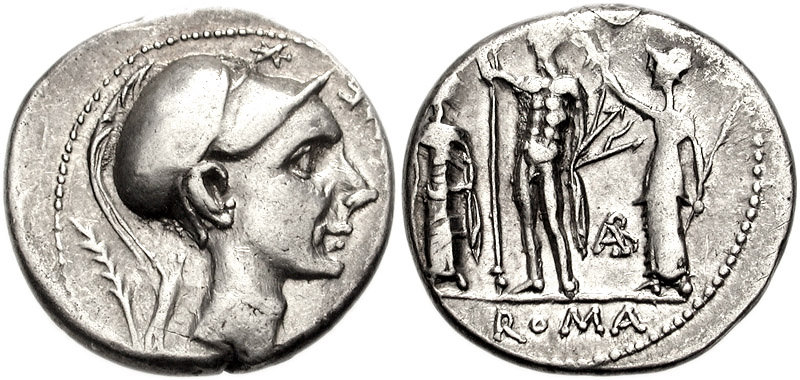|
Extraordinarii
The ''extraordinarii'' were the elite troops of the Roman alae, recruited from the ''socii'', Rome's Italian military allies. The name refers to their nature; i.e., ''extraordinary'' or ''chosen'' men. In battle they had many functions. Sometimes they were reserve troops. Other times they were rearguard, scouts, and pickets. The ''extraordinarii'' also served as bodyguards of the general. They were created after the Latin War and were dissolved after the Marian reforms. Recruitment Almost all the details we know of the ''extraordinarii'' are described to us in '' The Histories'' of the ancient Greek historian Polybius. The standard Consular army of the Republic was made up of two legions and a comparable number of Italian allied troops, termed the alae. In theory, the alae would be the same size as the legions, except for the cavalry, which was tripled; so, a standard ala would contain about 900 cavalry and 4,200 foot. In practice, there was often more allied infantry than Roman ... [...More Info...] [...Related Items...] OR: [Wikipedia] [Google] [Baidu] |
Roman Army Of The Mid-Republic
The Roman army of the mid-Republic, also called the manipular Roman army or the Polybian army, refers to the armed forces deployed by the mid-Roman Republic, from the end of the Samnite Wars (290 BC) to the end of the Social War (88 BC). The first phase of this army, in its manipular structure (290–c. 130 BC), is described in detail in the ''Histories'' of the ancient Greek historian Polybius, writing before 146 BC. The central feature of the mid-Republican army was the manipular organisation of its battle-line. Instead of a single, large mass (the phalanx) as in the Early Roman army, the Romans now drew up in three lines (''triplex acies'') consisting of small units (maniples) of 120 men, arrayed in chessboard fashion, giving much greater tactical strength and flexibility. This structure was probably introduced in c. 300 BC during the Samnite Wars. Also probably dating from this period was the regular accompaniment of each legion by a non-citizen formation of roughly equa ... [...More Info...] [...Related Items...] OR: [Wikipedia] [Google] [Baidu] |
Ala (Roman Allied Military Unit)
An ''ala'' (Latin for "wing", plural: ''alae'') was the term used during the middle of the Roman Republic (338–88 BC) to denote a military formation composed of conscripts from the ''socii'', Rome's Italian military allies. A normal consular army during the period consisted of two legions, composed of only Roman citizens, and two allied ''alae''. The ''alae'' were somewhat larger than normal legions, 5,400 or 5,100 men against the legion's 4,500 men, and it contained a greater quantity of cavalry, usually 900 horsemen against the 300 supplied by the Romans. From the time of the first Roman emperor, Augustus (ruled 27 BC – AD 14), the term ''ala'' was used in the professional imperial army to denote a much smaller (ca. 500), purely cavalry unit of the non-citizen auxilia corps: see ala (Roman cavalry unit). History When the Roman armies started being composed partly of Roman citizens and partly of ''socii'' (allies from the rest of the Italian mainland), either Latini or I ... [...More Info...] [...Related Items...] OR: [Wikipedia] [Google] [Baidu] |
Evocatus
An ''evocatus'' (plural ''evocati'') was a soldier in the Ancient Roman army who had served out his time and obtained an honorable discharge (''honesta missio'') but had voluntarily enlisted again at the invitation of the consul or other commander. Significance and tasks There always existed a considerable number of evocati in every army of importance, and when the general was a favorite among the soldiers, the number of veterans who joined his standard naturally increased. The evocati were officially released, like the '' vexillarii'', from common military duties such as fortifying the camp and making roads. Ranking Evocati held a higher rank in the army than common legionary soldiers and are sometimes written of in conjunction with the '' equites Romani,'' and sometimes classed with the centurions. Evocati appear to have been frequently promoted to the rank of centurion and were customarily entitled to bear the vine staff and discipline fellow soldiers. Thus, Pompey induced a gre ... [...More Info...] [...Related Items...] OR: [Wikipedia] [Google] [Baidu] |
Military Units And Formations Of Ancient Rome
A military, also known collectively as armed forces, is a heavily armed, highly organized force primarily intended for warfare. It is typically authorized and maintained by a sovereign state, with its members identifiable by their distinct military uniform. It may consist of one or more military branches such as an army, navy, air force, space force, marines, or coast guard. The main task of the military is usually defined as defence of the state and its interests against external armed threats. In broad usage, the terms ''armed forces'' and ''military'' are often treated as synonymous, although in technical usage a distinction is sometimes made in which a country's armed forces may include both its military and other paramilitary forces. There are various forms of irregular military forces, not belonging to a recognized state; though they share many attributes with regular military forces, they are less often referred to as simply ''military''. A nation's military may ... [...More Info...] [...Related Items...] OR: [Wikipedia] [Google] [Baidu] |
Ab Urbe Condita (book)
The work called ( en, From the Founding of the City), sometimes referred to as (''Books from the Founding of the City''), is a monumental history of ancient Rome, written in Latin between 27 and 9 BC by Livy, a Roman historian. The work covers the period from the legends concerning the arrival of Aeneas and the refugees from the fall of Troy, to the city's founding in 753 BC, the expulsion of the Kings in 509 BC, and down to Livy's own time, during the reign of the emperor Augustus. The last event covered by Livy is the death of Drusus in 9 BC. 35 of 142 books, about a quarter of the work, are still extant. The surviving books deal with the events down to 293 BC (books 1–10), and from 219 to 166 BC (books 21–45). Contents Corpus The ''History of Rome'' originally comprised 142 "books", thirty-five of which—Books 1–10 with the Preface and Books 21–45—still exist in reasonably complete form. Damage to a manuscript of the 5th century resulted ... [...More Info...] [...Related Items...] OR: [Wikipedia] [Google] [Baidu] |
Livy
Titus Livius (; 59 BC – AD 17), known in English as Livy ( ), was a Roman historian. He wrote a monumental history of Rome and the Roman people, titled , covering the period from the earliest legends of Rome before the traditional founding in 753 BC through the reign of Augustus in Livy's own lifetime. He was on familiar terms with members of the Julio-Claudian dynasty and a friend of Augustus, whose young grandnephew, the future emperor Claudius, he exhorted to take up the writing of history. Life Livy was born in Patavium in northern Italy, now modern Padua, probably in 59 BC. At the time of his birth, his home city of Patavium was the second wealthiest on the Italian peninsula, and the largest in the province of Cisalpine Gaul (northern Italy). Cisalpine Gaul was merged in Italy proper during his lifetime and its inhabitants were given Roman citizenship by Julius Caesar. In his works, Livy often expressed his deep affection and pride for Patavium, and the city was we ... [...More Info...] [...Related Items...] OR: [Wikipedia] [Google] [Baidu] |
Social War (91–88 BC)
Social War may refer to: * Social War (357–355 BC), or the War of the Allies, fought between the Second Athenian Empire and the allies of Chios, Rhodes, and Cos as well as Byzantium * Social War (220–217 BC), fought among the southern Greek states * Social War (91–87 BC), or the Italian or Marsic War, fought between the Roman Republic and several Italian cities {{disambig ... [...More Info...] [...Related Items...] OR: [Wikipedia] [Google] [Baidu] |
Marian Reform
The Marian reforms were reforms of the ancient Roman army implemented in 107 BC by the statesman Gaius Marius, for whom they were later named. The reforms originated as a reaction to the military and logistical stagnation of the Roman Republic in the late 2nd century BC. Centuries of military campaigning throughout the Mediterranean and increasing invasions and uprisings across Roman territory had stretched the human and physical resources of the Roman army. Marius proposed radical alterations with the intention of creating a more professional, permanent, and dynamic Roman army. The reforms revolutionized the Roman military machine, introducing the standardized legionary, the cohort unit and drastically altering the property and weaponry requirements for recruitment. The reforms also put the responsibility of supplying and managing an army in the hands of the general. Marius also granted citizenship and land to all Roman soldiers. The consequences of these reforms had a significa ... [...More Info...] [...Related Items...] OR: [Wikipedia] [Google] [Baidu] |
Battle Of Sentinum
The Battle of Sentinum was the decisive battle of the Third Samnite War, fought in 295 BC near Sentinum (next to the modern town of Sassoferrato, in the Marche region of Italy), in which the Romans overcame a formidable coalition of Samnites, Etruscans, and Umbrians and Senone Gauls. The Romans won a decisive victory that broke up the tribal coalition (the Etruscans, Umbrians, and Senones pulled out of the war) and paved the way for the Romans' complete victory over the Samnites. The Romans involved in the battle of Sentinum were commanded by consuls Publius Decius Mus and Quintus Fabius Maximus Rullianus. Background The Third Samnite War started when envoys from Lucania asked Rome for help against an attack on them by the Samnites. Rome intervened and the war started. Just prior to and during the first year of this, Rome was also facing a war with the Etruscans. In 297 BC the Romans received news that the Etruscans were considering suing for peace. As a result, both Roma ... [...More Info...] [...Related Items...] OR: [Wikipedia] [Google] [Baidu] |
Latin War
The (Second) Latin War (340–338 BC)The Romans customarily dated events by noting the consuls who held office that year. The Latin War broke out in the year that Titus Manlius Imperiosus Torquatus and Publius Decius Mus were consuls and ended in the year that Lucius Furius Camillus and Gaius Maenius were consuls. When converted to the western calendar using the traditional Varronian chronology, those years become 340 and 338 BC. However, modern historians have shown that the Varronian chronology dates the Latin War four years too early because of inclusion of unhistorical "dictator years". Despite that known inaccuracy, the Varronian chronology remains in use by convention also in academic literature and so is also the chronology used in this article. Forsythe(2005), pp. 369-370 was a conflict between the Roman Republic and its neighbors, the Latin peoples of ancient Italy. It ended in the dissolution of the Latin League and incorporation of its territory into the Roman sphere ... [...More Info...] [...Related Items...] OR: [Wikipedia] [Google] [Baidu] |
Prefect
Prefect (from the Latin ''praefectus'', substantive adjectival form of ''praeficere'': "put in front", meaning in charge) is a magisterial title of varying definition, but essentially refers to the leader of an administrative area. A prefect's office, department, or area of control is called a prefecture, but in various post-Roman empire cases there is a prefect without a prefecture or ''vice versa''. The words "prefect" and "prefecture" are also used, more or less conventionally, to render analogous words in other languages, especially Romance languages. Ancient Rome ''Praefectus'' was the formal title of many, fairly low to high-ranking officials in ancient Rome, whose authority was not embodied in their person (as it was with elected Magistrates) but conferred by delegation from a higher authority. They did have some authority in their prefecture such as controlling prisons and in civil administration. Feudal times Especially in Medieval Latin, ''præfectus'' was used to r ... [...More Info...] [...Related Items...] OR: [Wikipedia] [Google] [Baidu] |




